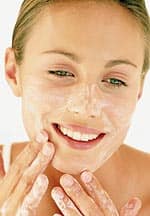Life Extension Magazine®
Tea has been prized throughout human history for its health-promoting effects. In ongoing research, scientists are discovering that the topical use of tea may confer numerous benefits to the skin. Rich in antioxidants, topically applied tea extracts help promote healthy, youthful skin. Skin is often thought of as the great envelope of the human body. It numerous and varied functions include external protection, temperature regulation, sensory detection, and toxin removal, as well as the specialty functions involving the hair and nails. One amazing property of skin is that it is continuously being made by our bodies. Skin reproduces itself approximately every 28 days, the time it takes for a newborn skin cell, or epidermal cell, to migrate and mature to the skin’s dry surface, known as the stratum corneum. The skin’s appearance is determined by its exposure to potentially harmful environmental influences such as sunlight and air pollution, in combination with diet and topical care. Promoting optimal skin appearance and function entails protecting and nourishing the skin as much as possible. It is important that these efforts target skin cells during their earliest stages of development, so that the older cells look and function as best they can. These efforts also play a large part in preventing many dermatological diagnoses, as well as skin cancer, the most common of all cancers. Red, green, white, and black teas from around the world have been used for centuries in various medicinal remedies. Modern research continues to elucidate the anti-aging and health-promoting effects of tea.1 Recent findings have shown that tea has antioxidant, anti-aging, anti-inflammatory, and anti-cancer benefits.2-10 When combined with other topical agents in skin care products, tea helps to enhance their effects, a synergy that helps improve the skin’s appearance, texture, and function. Frequent exfoliation allows active tea constituents to better penetrate the skin. Alpha-hydroxy acids are among the most beneficial exfoliating agents available today. Tea contains several of the most potent and protective antioxidant vitamins and phytochemicals for skin health. The most important of these are vitamins C and E, carotenoids, and flavonoids.11-15 Vitamin C contributes to human health in many important ways, including promoting the health and beauty of the skin. Vitamin C decreases production of the pigment melanin, allowing for lighter and brighter skin.16 It is required for collagen synthesis, which may contribute to fewer wrinkles,17-19 and also helps facilitate skin repair after an injury.20 Vitamin E is a strong antioxidant that is able to suppress free radicals in the skin.21 Its ability to be regenerated in the skin is enhanced by vitamin C.22 Carotenoids found in tea are potent fat-soluble antioxidants that help quench free radicals generated by ultraviolet rays.23 In addition to vitamin antioxidants and carotenoids, tea also contains 25-30% flavonoids, which include water-soluble plant pigments known as polyphenols. The major polyphenol in tea is epigallocatechin-3 gallate, or EGCG. Oral and topical use of tea and EGCG helps to inhibit inflammation and oxidative stress, and may help to prevent photoaging and cancers of the skin.24 The combination of these natural antioxidants improves skin health, giving it a smoother, brighter, and healthier appearance.
Research indicates that tea is a potent inducer of superoxide dismutase (SOD), an enzyme that quenches excess superoxide radicals and other reactive oxygen species.25-27 As adults reach the age of 60 and beyond, the amount of SOD in normal skin diminishes and is incapable of adequately neutralizing large amounts of reactive oxygen species.28-31 With environmental and other influences such as sunlight, smoking, and diet contributing to the generation of reactive oxygen species, it is critical to optimize SOD levels through the use of tea and other flavonoids. In addition to the beauty benefits of topical tea, natural fruit acids called alpha-hydroxy acids rejuvenate the skin by encouraging the shedding of old, sun-damaged cells on the skin’s surface.32-35 Alpha-hydroxy acids loosen the glue-like substances that bind skin surface cells to each other, allowing the dead skin to peel off and the skin underneath to emerge. This underlying skin has a fresher, healthier look, with a more even color and texture. Exfoliation with alpha-hydroxy acids also allows topical antioxidant agents such as tea to affect the newly exposed cells to greatest benefit. For optimal effects, frequent use of topical products containing tea in combination with exfoliating agents is recommended. Furthermore, oral supplementation with vitamins C and E, carotenoids, and omega-3 fatty acids can help to beautify the skin and boost its antioxidant status. Finally, eating a diet rich in flavonoids such as those found in brightly colored fruits and vegetables will help promote and preserve your skin’s health and beauty. | ||
| References | ||
| 1. Leigh D. Medicine, the city and China. Med Hist. 1974 Jan;18(1):51-67. 2. Hernaez JF, Xu M, Dashwood RH. Antimutagenic activity of tea towards 2-hydroxyamino-3-methylimidazo[4,5-f]quinoline: effect of tea concentration and brew time on electrophile scavenging. Mutat Res. 1998 Jun 18;402(1-2):299-306. 3. Pillai SP, Mitscher LA, Menon SR, Pillai CA, Shankel DM. Antimutagenic/antioxidant activity of green tea components and related compounds. J Environ Pathol Toxicol Oncol. 1999;18(3):147-58. 4. Isemura M, Saeki K, Kimura T, et al. Tea catechins and related polyphenols as anti-cancer agents. Biofactors. 2000;13(1-4):81-5. 5. Orner GA, Dashwood WM, Blum CA, et al. Response of Apc(min) and A33 (delta N beta-cat) mutant mice to treatment with tea, sulindac, and 2-amino-1-methyl-6-phenylimidazo[4,5-b]pyridine (PhIP). Mutat Res. 2002 Sep 30;506-507:121-7. 6. Orner GA, Dashwood WM, Blum CA, et al. Suppression of tumorigenesis in the Apc(min) mouse: down-regulation of beta-catenin signaling by a combination of tea plus sulindac. Carcinogenesis. 2003 Feb;24(2):263-7. 7. Henning SM, Fajardo-Lira C, Lee HW, et al. Catechin content of 18 teas and a green tea extract supplement correlates with the antioxidant capacity. Nutr Cancer. 2003;45(2):226-35. 8. Polovka M, Brezova V, Stasko A. Antioxidant properties of tea investigated by EPR spectroscopy. Biophys Chem. 2003 Oct 1;106(1):39-56. 9. Lee KW, Kim YJ, Lee HJ, Lee CY. Cocoa has more phenolic phytochemicals and a higher antioxidant capacity than teas and red wine. J Agric Food Chem. 2003 Dec 3;51(25):7292-5. 10. Park AM, Dong Z. Signal transduction pathways: targets for green and black tea polyphenols. J Biochem Mol Biol. 2003 Jan 31;36(1):66-77. 11. du TR, Volsteedt Y, Apostolides Z. Comparison of the antioxidant content of fruits, vegetables and teas measured as vitamin C equivalents. Toxicology. 2001 Sep 14;166(1-2):63-9. 12. Benzie IF, Szeto YT. Total antioxidant capacity of teas by the ferric reducing/antioxidant power assay. J Agric Food Chem. 1999 Feb;47(2):633-6. 13. Suzuki Y, Shioi Y. Identification of chlorophylls and carotenoids in major teas by high-performance liquid chromatography with photodiode array detection. J Agric Food Chem. 2003 Aug 27;51(18):5307-14. 14. Craig WJ. Health-promoting properties of common herbs. Am J Clin Nutr. 1999 Sep;70(3 Suppl):491S-9S. 15. Yen GC, Chen HY. Relationship between antimutagenic activity and major components of various teas. Mutagenesis. 1996 Jan;11(1):37-41. 16. Huh CH, Seo KI, Park JY, et al. A randomized, double-blind, placebo-controlled trial of vitamin C iontophoresis in melasma. Dermatology. 2003;206(4):316-20. 17. Raschke T, Koop U, Dusing HJ, et al. Topical activity of ascorbic acid: from in vitro optimization to in vivo efficacy. Skin Pharmacol Physiol. 2004 Jul;17(4):200-6. 18. Woessner JF, Gould BS. Collagen biosynthesis; tissue culture experiments to ascertain the role of ascorbic acid in collagen formation. J Biophys Biochem Cytol. 1957 Sep 25;3(5):685-95. 19. Van Robertson WB, Schwartz B. Ascorbic acid and the formation of collagen. J Biol Chem. 1953 Apr;201(2):689-96. 20. Kaplan B, Gonul B, Dincer S, Dincer Kaya FN, Babul A. Relationships between tensile strength, ascorbic acid, hydroxyproline, and zinc levels of rabbit full-thickness incision wound healing. Surg Today. 2004;34(9):747-51. 21. Kuchide M, Tokuda H, Takayasu J, et al. Cancer chemopreventive effects of oral feeding alpha-tocopherol on ultraviolet light B induced photocarcinogenesis of hairless mouse. Cancer Lett. 2003 Jul 10;196(2):169-77. 22. Buettner GR. The pecking order of free radicals and antioxidants: lipid peroxidation, alpha-tocopherol, and ascorbate. Arch Biochem Biophys. 1993 Feb 1;300(2):535-43. 23. Bando N, Hayashi H, Wakamatsu S, et al. Participation of singlet oxygen in ultraviolet-a-induced lipid peroxidation in mouse skin and its inhibition by dietary beta-carotene: an ex vivo study. Free Radic Biol Med. 2004 Dec 1;37(11):1854-63. 24. Katiyar SK. Skin photoprotection by green tea: antioxidant and immunomodulatory effects. Curr Drug Targets Immune Endocr Metabol Disord. 2003 Sep;3(3):234-42. 25. Chan P, Cheng JT, Tsai JC, et al. Effect of catechin on the activity and gene expression of superoxide dismutase in cultured rat brain astrocytes. Neurosci Lett. 2002 Aug 16;328(3):281-4. 26. Bergman M, Ahnstrom M, Palmeback WP, Wingren S. Polymorphism in the manganese superoxide dismutase (MnSOD) gene and risk of breast cancer in young women. J Cancer Res Clin Oncol. 2005 Jul;131(7):439-44. 27. Dolgachev V, Oberley LW, Huang TT, et al. A role for manganese superoxide dismutase in apoptosis after photosensitization. Biochem Biophys Res Commun. 2005 Jul 1;332(2):411-7. 28. Mori M, Hasegawa N. Superoxide dismutase activity enhanced by green tea inhibits lipid accumulation in 3T3-L1 cells. Phytother Res. 2003 May;17(5):566-7. 29. Choung BY, Byun SJ, Suh JG, Kim TY. Extracellular superoxide dismutase tissue distribution and the patterns of superoxide dismutase mRNA expression following ultraviolet irradiation on mouse skin. Exp Dermatol. 2004 Nov;13(11):691-9. 30. Lu CY, Lee HC, Fahn HJ, Wei YH. Oxidative damage elicited by imbalance of free radical scavenging enzymes is associated with large-scale mtDNA deletions in aging human skin. Mutat Res. 1999 Jan 25;423(1-2):11-21. 31. Muramatsu S, Suga Y, Mizuno Y, et al. Differentiation-specific localization of catalase and hydrogen peroxide, and their alterations in rat skin exposed to ultraviolet B rays. J Dermatol Sci. 2005 Mar;37(3):151-8. 32. Briden ME. Alpha-hydroxyacid chemical peeling agents: case studies and rationale for safe and effective use. Cutis. 2004 Feb;73(2 Suppl):18-24. 33. Kligman D, Kligman AM. Salicylic acid peels for the treatment of photoaging. Dermatol Surg. 1998 Mar;24(3):325-8. 34. Moy LS, Murad H, Moy RL. Glycolic acid peels for the treatment of wrinkles and photoaging. J Dermatol Surg Oncol. 1993 Mar;19(3):243-6. 35. Tse Y, Ostad A, Lee HS, et al. A clinical and histologic evaluation of two medium-depth peels. Glycolic acid versus Jessner’s trichloroacetic acid. Dermatol Surg. 1996 Sep;22(9):781-6. |


